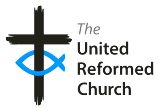
The Dunfermline United Reformed Church was formerly known as the Dunfermline Congregational Church and was formed from the Canmore Street Congregational Church established in 1840 and the North Congregational Church established in 1851 as the Bath Street Ecumenical Church. Since then a number of members from St.Paul's Church of Scotland joined following the dissolution of that church.
We are presently compiling the recent history from 1940 to the present date. The History of each of the early Churches is well told in the centenary booklets and reproduced here.
Contents
Canmore Street Congregational
Canmore Street Congregational Church
A Short History
In the History of the Church in Scotland the name of “Dunfermline” is one honoured for its association with movements that have in no small way influenced the course of that History. Within this ancient city dwelt Queen Margaret, the consort of Malcolm Canmore. If the reforming zeal of this undoubtedly pious woman ran in ways hardly to the liking of the supporters of the existing Celtic Church, it cannot be questioned that her reforms changed what was till then the accepted order in Scottish Church life. Here also lived the Rev.Ralph Erskine, the one-time minister of the Abbey Church but later the great leader of the Secession Movement. And within the city stands the church erected to the memory of the Rev.Thomas Gillespie who, deposed from his charge as minister of the neighbouring Parish of Carnock, founded the first Relief Church in Scotland.
Early Beginnings.
“After the most anxious enquiry”, it is said, “and a careful comparison of the different forms of church government with the Word of God, they came to the conclusion that the Congregational or Independent form of government and worship is the most conducive to purity of communion and is in accordance with the practice of the primitive churches as recorded in the New Testament”. So convinced, they sought to give effect to their convictions, and entered into correspondence with Dr. Lindsay Alexander of Augustine congregational Church, Edinburgh, and the Rev. G.D.Cullen, then a Congregational minister in Leith. A visit from these two gentlemen resulted in arrangements being made for the holding of services. A Hall in the Maygate capable of holding 200 was rented from a Mr.Rankine and services conducted by Mr.Cullen were commenced on Sunday, 15th December, 1839. Three diets of worship were held that day. Good as were the congregations at the forenoon and afternoon meetings, they were better still in the evening, for we learn that “the room was crowded to excess”.
By February of 1840 the young Church had a membership of 38 and desiring to be formally recognised and constituted as a Congregational Church, they asked that representatives of neighbouring churches be sent to Dunfermline for this purpose. The services of recognition were held on 6th March, 1840, and Canmore Street Congregational Church, Dunfermline, became added to the number of Congregational Churches in Scotland. That day also, four deacons were ordained, and as their names have been preserved in the Church records it is but right that, seeing they took upon themselves the great responsibility of directing the affairs of this young church, their names should be given here as a tribute to their memory:—Erskine Beveridge, who proved a staunch friend in the testing days which were to follow, Henry Kid. the first Treasurer of the Church, Thomas Grieve, and William Kirk.
Soon after this formal recognition of the Church, the members began to engage in regular church activities. A Sunday School was commenced and that it must have been of fair size can be gathered from the fact that fifteen members were appointed to act as Teachers. A Library was organised for the use of the congregation and Sabbath School members, and most detailed regulations for its use were drawn up. A committee was also formed to choose a suitable site on which to build a “chapel”. In September of that year the congregation moved from the Hall in the Maygate to the larger “Freemason Hall” which we understand was then situated in North Inglis Street. It is interesting to read that instructions were given to the responsible committee to have this Hall “seated” and “fitted up” as “comfortably and as economically as possible”. In that same month also, the present site of the Church was purchased. Plans for a building capable of seating 700 people and estimated to cost £1,200 were obtained and approved.
The Church though without a settled pastor and still a struggling cause committed itself to this great venture—surely one of singular faith and vision. One pictures these pioneers visiting the site after building operations had commenced, eagerly anticipating the day when they might enter upon possession of this House which was to he their future spiritual home.
Like so many movements of its kind, Canmore Street Church, whose History we would relate, began in most humble circumstances. According to a contemporary record, “a few individuals having become impressed with the evils of promiscuous communion, began to examine into the system of church government and discipline under which these evils were permitted”. It was in no spirit of schism that these “not many mighty not many noble” contemplated separation from the United Secession Church with which they were then associated, but disturbed in conscience and seeking a purer way in Christian fellowship they “began to examine into the system of Church government and discipline under which these evils were permitted”. The heart searching they knew is seen from the thorough manner in which they conducted their enquiries.
Revd. George Thomson It was a great day for the congregation when on Sunday, 2nd January, 1842, the temporary “Tabernacle” was vacated for the permanent “Temple”. Three services were held and, according to the “Scottish Congregational Magazine” for March of that year, these services were so successful that "Hundreds were unable to obtain admittance”.
During the next few years the Church passed through a difficult period. The heavy burden of debt became such a problem that it was found necessary in 1846 to form a special committee to enquire into the situation. Also about this time several resignations from membership are recorded, and it says much for the courage of the members that, despite the smallness of their numbers, the resignations were accepted rather than retain on the roll any who had compromised with essential Christian principles of Faith and Conduct. As an indication of the spirit of the Church, it may be mentioned that two men formerly connected with Wesleyan Methodism had applied for membership and were accepted only on their agreeing to avoid introducing “Wesleyan doctrinal peculiarities at the risk of disturbing the peace of this Church”.
The Rev.George Thomson resigned the pastorate on 24th December, 1846, on removing to London, and the Church bade him “God-speed” and expressed the hope that “wherever his lot be cast he may enjoy peace and prosperity”.
Whilst the Church still met in the Freemason Hall, the pulpit must have been supplied by ministers who acted as temporary pastors, for in April of 1841 a call to the pastorate was presented to the Rev. George Thomson, previously a Secession Minister in Campbeltown, who is referred to as “now labouring amongst us”. The stipend offered was £100, but the desire to do fairly by their minister is shown, for the Deacons who were deputed to present the call were instructed to advise Mr. Thomson that it was “the earnest desire of the church that as their numbers increase and circumstances otherwise improve, they should be enabled to add to his temporal comfort”. The call was accepted and Mr. Thomson must have begun his work shortly afterwards. Little information is available as to how the Church settled down with its first pastor, but in a letter of the period Mr. Thomson is described as “an excellent preacher, not telling or striking, but careful in his preparation, and lucid in his exposition”.
Revd. Robert Craig There is here a blank of ten years in the Church records and it is impossible to record much of Mr. Craig or the condition of the Church during his pastorate. From the letter he addressed to the Church advising them of his acceptance of the invitation, we gather that he was not blessed with too good health, and also that he had his own way of doing things. The date of Mr. Craig's departure is not available in any of the records of the time.
A successor was found in the Rev.Robert Craig of Lerwick. Mr. Craig was invited in May, 1847, and there must have been some feeling against “read” sermons at that time, as Mr.Craig was advised that the congregation “on ordinary occasions much disapproved of reading sermons”. In addition to the regular forenoon and afternoon services the new minister was asked to conduct an evening service once a month.
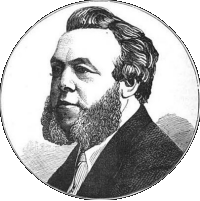 Revd.Alex. McAuslane, D.D.
Revd.Alex. McAuslane, D.D.
The next pastor was the Rev.Alexander McAuslane, who came to the Church straight from College and was ordained in 1852. He remained for six years, leaving in 1858 for a church in England. His preaching gifts must have been unusual as his services appear to have been in great demand. He later received a doctorate in Divinity. The Church enjoyed much prosperity during his ministry and the membership had increased to about 200 by the year of his departure. The minutes of the time indicate how much attached were the members to their minister and how very loath they were to part with him.
Church Praise
It was during Dr.McAuslan’s ministry that the question of an organ for the Church was first raised. As far back as 1846 we have a record that a committee was appointed to advise concerning the “conducting and improvement of the singing in the Church and congregation”. As a result four “brethren” agreed to lead the singing for a limited period and the committee suggested that a permanent Teacher of Music be appointed. Dissatisfaction must also have been felt with the standard of congregational singing again in 1858, as in that year very detailed information is given as to the duties of the “Leader of the Psalmody”. To remunerate him for his services the Church agreed to make an annual collection on his behalf. In this same year (1858) Mr.Erskine Beveridge made a '”Handsome and Liberal" offer of the gift of an organ for the Church. The generosity of the offer was appreciated by all, but there were some who had scruples of conscience, and proposed as an amendment that “We Respectfully decline the offer, believing an instrument in connection with Public Worship to be unnecessary and unwarranted by the Word of God”. The amendment, however, failed. The organ was installed and formally opened, to the great satisfaction — and shall we not say “Pride” — of the congregation on Friday, 25th November, 1859. It is this Organ — later much enlarged and altered — that is still in use, and it is believed to
have been the first pipe organ in any Dunfermline Church.
Revd. John Hutchison With the settlement of Mr.Hutchison the Church entered on a period of increased prosperity. The earlier financial difficulties were overcome, and in every way the influence of the Church upon the life of the city was enlarged. During his ministry he compiled a new Hymn Book for the congregation, and so much did the work flourish that the Church was able to afford a professional organist.
Interest in Evangelistic work in the District was strong about this time, as a “Mr.Swinton” is referred to as the Church’s Evangelist for the neighbouring villages. There was also a proposal put forward to establish a Mission Sunday School in addition to the Church Sabbath School. The Church continued to prosper under Mr.Hutchison’s pastership and in 1865 a Manse was purchased. The death of Mr.Erskine Beveridge in this year was a great blow as he had been a true friend and in the early days had taken much of the burden of finance upon his own shoulders. Before his death, he had arranged for plans to be prepared with a view to providing proper Hall accommodation, but these plans were not put into use until some years later. Mr.Hutchison, to the obvious regret of his Dunfermline friends, closed his ministry amongst them on his departure to Ashton-under-Lyme in September, 1865.
After a pastoral vacancy of only a few months, an invitation was extended to the Rev.John Hutchison of Elie. The call was signed by 176 members
 and in accepting it Mr.Hutchison felt himself “constrained cheerfully” to cast in his “lot” with his new congregation. An interesting reminder of the Church's foundation principle of “Purity of Communion” is given to us in a minute of 1859, when in accepting two applicants for membership bringing certificates from the “United Edinburgh Independent Church”, it was agreed that in future “all applicants who may come from churches on the principle of pure communion be received in the same way”. Hitherto it had been the practice for all applicants, whether joining a church for the first time or transferring from other churches, to be interviewed by church members and their Christian character reported upon.
and in accepting it Mr.Hutchison felt himself “constrained cheerfully” to cast in his “lot” with his new congregation. An interesting reminder of the Church's foundation principle of “Purity of Communion” is given to us in a minute of 1859, when in accepting two applicants for membership bringing certificates from the “United Edinburgh Independent Church”, it was agreed that in future “all applicants who may come from churches on the principle of pure communion be received in the same way”. Hitherto it had been the practice for all applicants, whether joining a church for the first time or transferring from other churches, to be interviewed by church members and their Christian character reported upon.
Revd. Professor James Robbie The project of erecting a Church Hall, which had been previously deferred, was made possible in 1867 by a legacy left to the Church for this purpose by Mr.Henry Inglis. The necessity for more deacons was felt in 1873, and the Church agreed to add four to the number then in office. In 1881 the state of Professor Robbie's health gave great cause for concern. Some years previously he had had a breakdown but had recovered sufficiently to allow him to resume his duties. Throughout the year 1881 the Professor was absent
a good deal from his pulpit, and although given leave of absence to allow of rest, he found it necessary to tender his resignation. It is a tribute to the loyalty of the members to their pastor that they refused to accept this resignation when first tendered, and sought other ways to meet the situation. But in November of this year, the Professor again placed his resignation before the Church, and with much reluctance and with deep regret it was accepted. As a token of esteem and in appreciation of his great services, an address in eulogistic terms was presented to the Professor along with a generous money gift. The Church also agreed to grant their pastor a retiring allowance.
Coming to Dunfermline from the seaport town of Fraserburgh towards the close of 1865, Mr.Robbie quickly settled down to his new work and established
 a reputation as a scholarly preacher and a sympathetic pastor. The Church became knit together into a strong and influential fellowship. In the sixteen years’ ministry of Mr.Robbie — appointed a Professor of the Theological Hall in Edinburgh in 1871, and continuing at the same time his pastoral duties — we see the Church increasing in numbers, widening in its influence and becoming what it has ever since been — a Church recognised for its interest in all good causes and all that pertains to the wellbeing of the Denomination and the furtherance of Christ's Kingdom at home and abroad.
a reputation as a scholarly preacher and a sympathetic pastor. The Church became knit together into a strong and influential fellowship. In the sixteen years’ ministry of Mr.Robbie — appointed a Professor of the Theological Hall in Edinburgh in 1871, and continuing at the same time his pastoral duties — we see the Church increasing in numbers, widening in its influence and becoming what it has ever since been — a Church recognised for its interest in all good causes and all that pertains to the wellbeing of the Denomination and the furtherance of Christ's Kingdom at home and abroad.
Revd. Fred Binns The organ appears to have given trouble about this time as a complete overhaul was found to be necessary and was undertaken in April, 1884. In this year also a “Leader of the Psalmody” was appointed to co-operate with the Organist in the leading of the Praise of the Church. Mr.James Simpson was unanimously appointed and continued to hold office until 1894. Mr.Simpson died in 1939, and for many years after ceasing to lead the Churche's Praise he continued to serve as conductor of the Children's Choir. As a sidelight upon the times it might be mentioned that the conditions of appointment of the Church Officer were reviewed in 1886, and his salary then fixed at £12 p.a., but this sum being unacceptable to him it was increased to £l3—the increase being descried as “a somewhat higher figure”
The question of the observance of Holy Communion arose in this same year, 1884. Hitherto the Sacrament had been celebrated weekly but the Deacons, after considerable discussion spread over several months, recommended that the weekly observance be changed to monthly. Although the advisability of a change was suggested to the Church in 1884, the matter was deferred several times and it was not until March 1889 that approval was given and the new method adopted. The Communion service again came up for discussion in May of 1889, when the Church meeting approved of the suggestion that the whole congregation be encouraged to remain during the observance of
the Sacrament and that the whole service be made to bear upon it.
The Mission Sunday School, which had for some time been conducted in premises in Carnegie Street, was transferred to the “New Drill Hall” in Bruce Street in 1889.
Mr.Binns having received a call from Redfern Church. Sydney, N.S.W., decided to accept this invitation and resigned from the pastorate in November, 1889, thereby bringing to a conclusion a ministry which had brought much blessing to the Church and raised it to a height of spiritual and temporal prosperity that it had not known before. There are still amongst us those who remember Mr.and Mrs.Binns and relate with what deep regret the Church parted with them when they left for the southern continent. Their departure in 1889 can be said to bring to a close an era in the Churches history.
With the coming of the Rev.Fred Binns from Dumfries in 1882, the task of consolidating the work of the Church was continued. Mr.Binns came with an excellent reputation as an acceptable preacher and a devoted pastor,
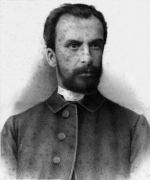 and it was not long before the Church felt the impact of his vigorous personality. The minutes of Church meetings show long lists of the names of those applying for membership, which is in itself an indication that many were being drawn to the Church through Mr.Binns' influence.
and it was not long before the Church felt the impact of his vigorous personality. The minutes of Church meetings show long lists of the names of those applying for membership, which is in itself an indication that many were being drawn to the Church through Mr.Binns' influence.
Revd. D.L.Ritchie, D.D. With the settlement of Mr.Ritchie, the Church entered upon a period of great expansion and increased activity. His vigorous preaching, his organising abilities and his attractive personality drew not only his own members to him, but also many then unconnected with any church. Congregations increased in numbers, many additions were made to the membership, and in all the Church activities, a sense of new life was felt that reflected the vigorous personality of the young pastor.
Mr.Ritchie, as he then was, visited the Church as “Pulpit Supply” on Sunday,
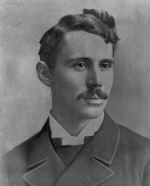 1st December, 1889, and created so favourable an impression that he was asked to preach on the two following Sundays. This impression was confirmed, and on 16th December the Church presented to him an unanimous and most enthusiastic invitation to become their pastor. Mr.Ritchie was at that time an assistant in St.Paul's Church, Leith. The new minister was ordained on 9th January, 1890 — this being the first ordination service believed to have taken place in the Church.
1st December, 1889, and created so favourable an impression that he was asked to preach on the two following Sundays. This impression was confirmed, and on 16th December the Church presented to him an unanimous and most enthusiastic invitation to become their pastor. Mr.Ritchie was at that time an assistant in St.Paul's Church, Leith. The new minister was ordained on 9th January, 1890 — this being the first ordination service believed to have taken place in the Church.
The Church's Jubilee Special services were held on Sunday, 21st September, 1890, when Rev.J.M.Jarvie of Greenock preached along with Mr.Ritchie. A “Soiree” was held on the Monday evening following, at which representative ministers were present to convey the greetings of the Denomination and of sister churches in the city. Perhaps most pleasing of all was the presence of at least three — there may have been others — of those who had been associated with the Church since its formation.
Mr.James Dickie, Mr.William Robertson and Mr.David Watson are referred to by name in a “Press” account of the proceedings as those who could claim association with the Church from the day when the first service was held. The celebrations were continued throughout the week. On the Tuesday evening a symposium of Congregational Ministers was held; on the Wednesday and Thursday, Evangelistic services were conducted, and on the Friday a Rally for Young People took place. The celebrations were counted a great success and contributed much to the deepening of the Church's spiritual life.
With the celebrations over, the Church settled down with increased enthusiasm for its growing work. For the next few years several matters of importance were to occupy the attention of the Minister, Deacons and Members. The question of an increase in the number of Deacons was suggested in 1890, but not until 1891 were the additions made, bringing up the number to eleven. The matter of a Missionary Assistant was also considered. An extension had been made in Mission-school work and by 1892 the Church was responsible for three such schools, one in the Drill Hall, Bruce Street, another in Rolland Street, and a third in Wellwood. From 1892 until 1908 assistants to the pastors were appointed to aid them in this work.
The major question which came before the Deacons in 1892 was the enlarging of the Church and the provision of more adequate Hall accommodation. The scheme proposed entailed an estimated expenditure of £1,500 and having met with the approval of the Church, was commenced in the autumn of 1893 and completed in the early months of 1894. During the time that the Church was being enlarged, services were held in St.Margaret's Hall. Re-opening services were held on January 14th and a Social Meeting on January 16th.
For many years after the death, about 1862, of Mr.Leason, the second professional organist of the Church, the organ had been played by voluntary organists, amongst those being Miss Beveridge, Mrs.Robbie, Miss Erskine (Mrs.Wood), and Mr.J.W.Robertson. In February, 1894, Mr.A.A.Campbell of Arbroath was appointed Organist and Choirmaster and in this capacity gave 42 years of most faithful service until his death in 1936. Soon after Mr.Campbell’s appointment, the organ was completely overhauled and new pipes added, the gift of the late Mr.George Reid. Mr.Campbell was succeeded by Mr.Joseph Fettes, L.R.A.M. The present Organist and Choirmaster, Mr.W.Clifford Jenkins, L.R.A.M., A.R.C.M., was appointed in 1938.
A further election of Deacons took place in 1894 when six new deacons were added to those then in office, increasing the number to fourteen. Mr.Rattray, the pastor's assistant, having resigned, Mr.A.G.H.Sivewright, M.A., a scholar under the “Baxter Trust”, was appointed his successor. Mr.Sivewright remained until February 1896 when he was inducted to the Church in St.Andrews.
After seven years of most successful work in Dunfermline, during which he had seen the Church develop considerably under his guidance, Mr.Ritchie received and accepted an unanimous call to succeed that famous preacher the late Dr.Jowett in the pastorate of St.James’ Congregational Church, Newcastle. Mr.Ritchie, in later years was honoured with a Doctorate in Divinity and subsequently became Principal of Paton Congregational College, Nottingham, and later Dean of the Faculty of Divinity in McGill University, Montreal.
All this was a fine preparation for the celebration of the Church's Jubilee, which took place in the week commencing 21st September, 1890. From small beginnings we have seen the Church grow in numbers and increase its power for good in the community. A fine Church building had been erected and equipped, a Hall had been built, a Manse procured. The Church had been served by six ministers, all of whom had contributed to the success of the work — those of the earliest period laying secure foundations and those of later years building upon those foundations a fellowship in which all its members were bound together by the bond of their devotion to Christ and their service for the Kingdom of God. Those members having personal links with the early days, on looking back and comparing the state of the Church in 1890 with the prospects held out in 1840, could find much to rejoice their hearts. Throughout the years the Church had been faithful to the vision of its founders, and was now proving a worthy instrument in God's hands for the extension of His Kingdom.
Revd. Alexander MacLennan, M.A. It was during Mr.MacLennan's ministry that evening services in place of afternoon services were commenced during the winter months, and a “News Letter” started. The Congregational Church Hymnal was introduced in 1898, and in the following year the Mission Sunday School work being carried on in the Co-operative Hall was transferred to the Rolland Street premises. Mr.MacLennan had as his assistants Mr.R.Stein, who in 1902 became minister of the Tillicoultry Church; Mr.Strachan, who entered Paton College, Nottingham,
in 1903; Mr.William Orr, who left in 1904; and Mr.Walter Terrett, who completed his engagement in March. 1906. A fire occurred in 1904, when considerable damage was done to the Church Halls. In that year Mr.R.E.Walker presented the Church with the Individual Communion Set, which has been in use ever since. Additions to the Deacons were made in March of 1905, seven being added to those then serving.
It was on October 22nd of 1905 that Mr.MacLennan preached his last sermons in the Church he had served with such devotion. Illness overtook him that month and, although he lay an invalid until the following June, he was never again to proclaim to his people the “unsearchable riches of Christ”. To the great sorrow of all who knew him and loved him he passed away on 8th June, 1906. Such was the hold that this saint of God had gained upon the town, that the whole community mourned his passing and many were the tributes paid to the beauty of his character and the fine quality of his life. In token of appreciation of all he had meant to them, the Church erected a memorial over his grave in the Dunfermline Cemetery. So was brought to a close one of the finest partnerships that ever existed between a Pastor and his people.
It is not often that a church invites a minister to its pastorate and,
 on his declining, presents the invitation a second time. This unusual happening was experienced by Canmore Street Church before it had the satisfaction of welcoming Mr.MacLennan as its new pastor. When the call was first presented in June, 1896, Mr.MacLennan had only been one year at Wick and felt that he could not then leave. The call was repeated in January, 1897, and to the great joy of all was this time accepted. Mr.MacLennan began his Dunfermline ministry on Sunday, 28th February, that year. The name “Mr.MacLennan” is still remembered and revered by many in the Church and the town. He had to an unusual extent the quality of drawing people to him. Deeply beloved by old and young in his own congregation, he was held in the highest esteem throughout the community. So closely was his name associated with the town of his adoption that he became known in the denomination as “MacLennan of Dunfermline”. His nine years’ ministry left a permanent mark upon the Church. In outward things his work was crowned with success — great congregations gathered Sunday by Sunday to hear his messages, and many joined the Church under his influence. In the deeper things also his influence upon men and women was most marked, and the influence for good of this “Holy man of God” was remembered with gratitude for may years.
on his declining, presents the invitation a second time. This unusual happening was experienced by Canmore Street Church before it had the satisfaction of welcoming Mr.MacLennan as its new pastor. When the call was first presented in June, 1896, Mr.MacLennan had only been one year at Wick and felt that he could not then leave. The call was repeated in January, 1897, and to the great joy of all was this time accepted. Mr.MacLennan began his Dunfermline ministry on Sunday, 28th February, that year. The name “Mr.MacLennan” is still remembered and revered by many in the Church and the town. He had to an unusual extent the quality of drawing people to him. Deeply beloved by old and young in his own congregation, he was held in the highest esteem throughout the community. So closely was his name associated with the town of his adoption that he became known in the denomination as “MacLennan of Dunfermline”. His nine years’ ministry left a permanent mark upon the Church. In outward things his work was crowned with success — great congregations gathered Sunday by Sunday to hear his messages, and many joined the Church under his influence. In the deeper things also his influence upon men and women was most marked, and the influence for good of this “Holy man of God” was remembered with gratitude for may years.
(pdf version of the "Memoirs and Sermons of Alexander Maclennan published in 1906)
Revd. Andrew Ritchie, M.A. As an indication of the prosperous condition of the Church at this time it may be mentioned that there were 507 members on the roll at the close of 1909, and the Church had the distinction of distributing more copies of the London Missionary Society “Chronicle” than any other church in Great Britain.
In October of 1910 Mr. Ritchie received an invitation to the historic Dundas Street Church, Glasgow, and, proud as were the members at this distinction conferred upon their minister, it was with great reluctance that they allowed him to leave them for the “Congregational Cathedral” of the West.
It was no easy task that was set the Rev.Andrew Ritchie when in November of 1906 he was called to follow in the footsteps of one so beloved as the
 late Pastor. Mr.Ritchie had recently returned to this country from a period of service as minister of the “English American Church” at St.Petersburg”· (now Leningrad), and his stay in Russia had invested him in the eyes of his new congregation with something of the romantic. It was not long before he established himself in the affections of his people and although his ministry was of short duration — all too short for the congregation that had become sincerely attached to him — this pastorate at Dunfermline is one of happy memories of a telling preacher and a gracious pastor. During Mr.Ritchie’s ministry two outstanding ministers of the denomination visited the town — Dr.Campbell Morgan of London came in August of 1908 and addressed a Public Meeting in St.Margaret's Hall under the auspices of the London Missionary Society, and the Rev.Principal Forsyth of Hackney College, London, was the Anniversary Preacher at Canmore Street in March, 1909. As Missionary Assistant to Mr.Ritchie, Mr.Robert Wilson of Aberdeen was engaged for six months from October, 1908. The organ requiring attention, an extensive alteration and improvement was effected in 1909 when additions were made to the pipes and the consol was removed from behind the pulpit to its present position in the centre of the choir range.
late Pastor. Mr.Ritchie had recently returned to this country from a period of service as minister of the “English American Church” at St.Petersburg”· (now Leningrad), and his stay in Russia had invested him in the eyes of his new congregation with something of the romantic. It was not long before he established himself in the affections of his people and although his ministry was of short duration — all too short for the congregation that had become sincerely attached to him — this pastorate at Dunfermline is one of happy memories of a telling preacher and a gracious pastor. During Mr.Ritchie’s ministry two outstanding ministers of the denomination visited the town — Dr.Campbell Morgan of London came in August of 1908 and addressed a Public Meeting in St.Margaret's Hall under the auspices of the London Missionary Society, and the Rev.Principal Forsyth of Hackney College, London, was the Anniversary Preacher at Canmore Street in March, 1909. As Missionary Assistant to Mr.Ritchie, Mr.Robert Wilson of Aberdeen was engaged for six months from October, 1908. The organ requiring attention, an extensive alteration and improvement was effected in 1909 when additions were made to the pipes and the consol was removed from behind the pulpit to its present position in the centre of the choir range.
Revd. R.M.Moffat, M.A. Having received an invitation from the Church at Buxton, Mr.Motfat resigned his pastorate at Dunfermline on 4th December, 1912, and with the good wishes of the Church, left for his new sphere in January of the following year.
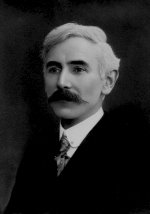 In seeking a successor to Mr.Ritchie, the Church for the first time in its history went South of the Border and on 28th December, 1910, extended an unanimous invitation to the Rev.R.M.Moffat, M.A., of Frome, Somerset. During the vacancy the Diaconate was increased to twenty-four members and to make up this number thirteen additional deacons were elected in February 1911. The Church received several legacies for its Home and Foreign Mission Funds about this time. A gift was also made by the late Sir William Robertson of four silver Communion plates.
In seeking a successor to Mr.Ritchie, the Church for the first time in its history went South of the Border and on 28th December, 1910, extended an unanimous invitation to the Rev.R.M.Moffat, M.A., of Frome, Somerset. During the vacancy the Diaconate was increased to twenty-four members and to make up this number thirteen additional deacons were elected in February 1911. The Church received several legacies for its Home and Foreign Mission Funds about this time. A gift was also made by the late Sir William Robertson of four silver Communion plates.
Revd. W.Selby Stein, M.A. (The Great War 1914-1918) All through the first War Dunfermline was a centre for the billeting of Troops. To meet the need for Social Centres, clubs were organised throughout the town. On 15th August, 1914, the Church handed over its entire suite of Halls for the use of the South club, which was then established in the Church premises. The Club became a “Home from Home” and many were the expressions of appreciation for the facilities granted and the good fellowship enjoyed.
Some idea of the work carried through by those responsible for the club can be gathered from the fact that some 50,000 letters were posted annually from the premises and approximately half a million meals were served during the duration of the War.
A feature of the Soldiers’ Club was the Special Sunday evening service held in the Hall conducted by Mr. Stein and other ministers. The occupation of the Hall necessitated readjustments in the carrying on of such Church work as was possible. The Sunday School and Bible Class were held in the Church, as also was the Band of Hope, the meetings of the Missionary Working Society were discontinued, and the Boys’ Brigade disbanded.
The War saw the building of the Garden City of Rosyth. The Congregational Union of Scotland proposed establishing a church at Rosyth to meet the needs of the growing community. An appeal to support the venture was made to Canmore Street Church, which took the new cause under its wing. In addition to financial assistance, the members of Canmore Street helped forward the project by a personal canvass of the district and by attendance at the services when the church was formed. Indeed, this was not the limit of the help given, as at one time members of Canmore Street Church acted as Beadle and even undertook the duties of church cleaners. With the change in the status of the Dockyard on the conclusion of the War, the new church saw many of its members leave the district, and when a disastrous fire destroyed the building the cause was abandoned.
Canmore Street Church did not forget her many sons who were on Active Service, and sought by means of letters, Xmas cards and Xmas parcels to keep them in touch with their Church and to assure them she was still mindful of them. Of those connected with the Church who served, twelve made the supreme sacrifice, and among them were some whom the Church had regarded as her future leaders.
The work of the minister was no light task in these days, but difficult as it must have been, there would be rewards for the extra demands made upon him and the work of the Church was faithfully continued. Mr.Stein was in Dunfermline for almost the whole of the War period but left in 1918 when he accepted a call to Trinity Congregational Church, Leeds. So ended a very happy association in spite of difficult war conditions.
Coming to Dunfermline from Princes Street Church, Dundee, with a reputation as an arresting preacher, Mr.Stein, who was invited to the pastorate on 29th May, 1913, entered on a ministry which was to be overcast by the deep
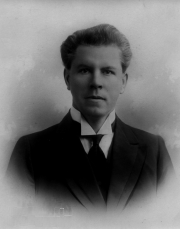 shadow of the Great War. The new minister had hardly settled down before the Church felt the upheaval of the War. With men away on active service and women engaged in munition work, the absence of so many made the carrying on of the several organisations extremely difficult. Some of the organisations had to close down and others could be continued only on a modified scale, if certain avenues of service were closed, others were opened, and deserving of special notice because of the excellent service rendered through it, was the Soldiers' Club.
shadow of the Great War. The new minister had hardly settled down before the Church felt the upheaval of the War. With men away on active service and women engaged in munition work, the absence of so many made the carrying on of the several organisations extremely difficult. Some of the organisations had to close down and others could be continued only on a modified scale, if certain avenues of service were closed, others were opened, and deserving of special notice because of the excellent service rendered through it, was the Soldiers' Club.
Revd. Dr.John Safeley, M.A. With the problems of the Post-War world before them the Church in December, 1919, called the Rev.John Safeley, M.A. (later Ph.D.), of Hillhead Church, Glasgow. Before the settlement of the new minister the Church was redecorated and electric light installed. The years following upon the War were difficult years for the churches in Dunfermline as, owing to the severe depression in the staple industry of the town, many families were compelled to leave for other districts where work was more plentiful. Not a few of the families connected with Canmore Street Church emigrated to America and the colonies about this time. Despite these difficulties of the times, the work of the Church progressed. Organisations that had been disbanded were resuscitated, and new ones commenced. A Manse was again purchased and generous support given to the Central Fund of the Congregational Union.
The Church's memorial to those who lost their lives in the Great War was placed on the front of the pulpit and dedicated at a special service held on 3rd October, 1920. Because a change in the needs of the district made the work no longer necessary, Rolland Street Mission — the last of the Church's Missions to remain open — was closed down in 1921. Thus was brought to a conclusion a not inglorious association, maintained by the Church over a long period with Mission work in the City and the surrounding district.
Dr.Safeley’s ministry was remarkable for the success which attended experiments in a less formal evening service. Dr.Safeley left for Hawick in 1934 and the Church retains memories of his high standard of preaching and his gracious ministry to the sick, aged and bereaved. It was during his ministry that a silver baptismal bowl was presented and a “Private Communion Set” gifted to the Church.
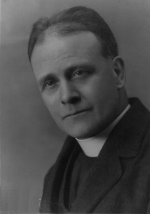 With the conclusion of hostilities in 1918 the Church, in common with all other churches, was faced with the problems of reconstruction after the havoc wrought by four long weary years of War. As is only too well known, the War left its mark upon every aspect of National life, and not least upon the Religious Life.
With the conclusion of hostilities in 1918 the Church, in common with all other churches, was faced with the problems of reconstruction after the havoc wrought by four long weary years of War. As is only too well known, the War left its mark upon every aspect of National life, and not least upon the Religious Life.
Revd. T.Aeron Lewis, M.A. Early in his ministry Mr. Lewis inaugurated a new Youth organisation known as “The Young Canmorians”, which had undoubted success. Extensive repairs having been carried out to the roof of the Church in 1934, the building was redecorated in the following year and the organ again overhauled. At the same time an apparatus for assisting the deaf members of the congregation was installed and proved a great boon. In the following year the cloakroom accommodation in the Halls was extended and brought up to date, and in 1937 the Manse was completely redecorated, and the lighting and heating systems brought up to modern standards. With the redecoration of the Halls it was felt that the Church buildings generally would be in excellent repair at the end of the first century of the Church's life. A corporation street widening scheme, involving an alteration in the policies in front of the Church, was carried out in such a way as to enhance the appearance of the buildings and improve the entrances.
With the advent of the Centenary, plans for the winter's work in 1939 were laid with enthusiasm. With pastor and people happily united and the various organisations of the Church in a healthy state, hopes were high for a great spiritual re-awakening. The outbreak of war, however, necessitated the curtailment of the pre-arranged programme, and the occupation of part of the Hall premises, the black-out regulations, and the calls of the Services created difficulties in the carrying on of much of the usual winter work.
A native of Wales, the present Pastor began his ministry in October 1934.
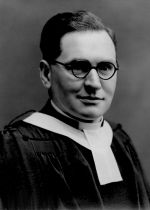 Mr.Lewis while still a student at the Scottish Congregational College in Edinburgh, supplied the pulpit during the vacancy following Dr.Safeley’s departure, and so impressed the Church that he was invited to preach again, and having completed his studies in the summer of 1934 was unanimously called to the Pastorate. The Ordination and Induction services inaugurating the new ministry were a source of impetus to the life of the Church, and the new pastor quickly established a reputation as a preacher, and a keen worker amongst the youth of the congregation. Young enough to look at the problems of modern youth with an understanding eye, he quickly endeared himself to the younger members of the families of the Church, at the same time making an immediate place for himself in the regard of the older members, his bright personality, kindly manner and real Christian sympathy making him a particularly welcome visitor in cases of sickness and infirmity.
Mr.Lewis while still a student at the Scottish Congregational College in Edinburgh, supplied the pulpit during the vacancy following Dr.Safeley’s departure, and so impressed the Church that he was invited to preach again, and having completed his studies in the summer of 1934 was unanimously called to the Pastorate. The Ordination and Induction services inaugurating the new ministry were a source of impetus to the life of the Church, and the new pastor quickly established a reputation as a preacher, and a keen worker amongst the youth of the congregation. Young enough to look at the problems of modern youth with an understanding eye, he quickly endeared himself to the younger members of the families of the Church, at the same time making an immediate place for himself in the regard of the older members, his bright personality, kindly manner and real Christian sympathy making him a particularly welcome visitor in cases of sickness and infirmity.
Office-Bearers
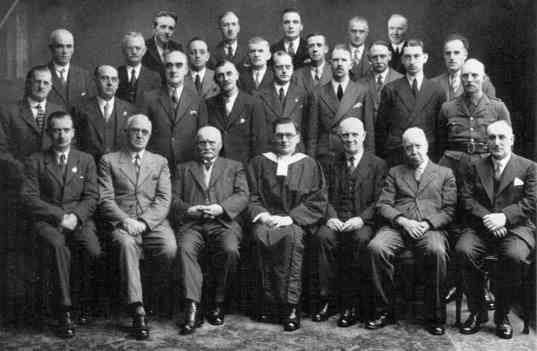
No History of the Church would be complete without some reference to the Diaconate and office-bearers. No records of the Diaconate are extant prior to 1877, but in earlier years the name of Erskine Beveridge is constantly referred to in the Minutes of the Church. One of the founders of the cause, his wise counsel must have been invaluable. His purse was always at the service of the Church and for his generous gifts and financial support those who followed him had much cause for gratitude. In 1877 the deacons were five in number—Messrs.John Brown, James Dickie, William Mackenzie, William Robertson and David Watson. These gave faithful service for many years until advancing age or death removed them from office and their places were taken by others.
Amongst the most notable deacons and office-bearers of more recent times the mind readily recalls the names of George Reid, R.E.Walker, Peter M.Connell, Sir William Robertson, Peter Keir, Andrew Allan, Henry Morris and Alexander Munro. It is with the deepest regret that in this Centenary year the Church mourns the loss of Charles Donaldson Allister, for so many years the Church President. He was beloved by every member and adherent. Many other names could be added, but those given are worthy representatives of the men who in their day contributed much to the life of the Church.
Tribute also should be paid to the women members of the Church who, like Dorcas of old, were “Full of good works” In Sunday School, Band of Hope, Choir and Guild and indeed in every aspect of the Church's life they have been most active, nobly bearing their share of the work and loyally serving the Church. Their work for Missions has always been and continues to be outstanding.
In bringing this survey to a close we cannot but express our sense that in reading the records of men’s past activities we have also been reading the recordings of God’s presence with His people. Despite all those frailties, misgivings and limitations shared by the members with all things human, there has gone forth from this Church an influence making for the betterment of human life, for the strengthening of Christian Character and for the building of that house “Not made with hands, eternal in the heavens”.
When the present day members gather to celebrate the Centenary of the Church they will be compassed about by a “Great cloud of witnesses”, and it were well that, proud of the great heritage into which they have entered, they make it their prayer that in this day of darkness and difficulty they may not be “Disobedient unto the heavenly vision” but may be given grace to “Press on for the prize of the high calling of God in Jesus Christ” that His way may be done and His Kingdom come.
North Congregational Church
A Short Historical Sketch 1851 - 1951
The North Congregational Church of Dunfermline originated in the secession, about 1848, of several members of Chalmers Street United Presbyterian Church who were attracted by the "new views" of the Rev. James Morison of Kilmamock.One of the early meeting places of this body was the Gellet Farm, whose proprietor, Robert Husband, was a founder of the Church, with which his family's name has never ceased to be honourably linked. For a time the group existed as a branch of Brighton Street Church, Edinburgh, of which they actually became members although at that period it took very much longer to reach Edinburgh than it does now. In January, 1851, however, they established themselves independently as "The Church Worshipping in Mason's Hall, Maygate". Mr. George Wisely, a student in the Theological Hall, undertook to act as minister, and as such he was greatly esteemed though he was never ordained in Dunfermline.
Shortly after the ordination of the first minister in 1853, the congregation moved to the Music Hall which had been built some time before in Guildhall Street. In 1855 the congregation left that building to worship in what later became known as the Y.W.C.A. Hall, Bath Street, opposite our present church.
Difficulties were great at this time and more than one meeting was held to consider the advisability of continuing. The Church seems to have been so poorly ventilated that ministers delivered their discourses only at the cost of much personal discomfort from the oppressive atmosphere. It is reported that once when the Managers remonstrated with the Rev. J. Frame for having discarded his coat to preach in his shirt-sleeves, his reply was, "If you don't give me more air, I will take off my vest too"!
When Mr.Frame resigned in 1856 pulpit supply was maintained by students. Under those conditions the congregation lost heart, and once more the Managers thought of closing the doors. Only by the personal intervention of the Home Mission Secretary, who travelled specially from Glasgow for the purpose, was the situation saved.
The coming of the Rev.N.Galloway in 1862 acted as a fresh stimulus. As the membership increased steadily he advocated the acquisition of new premises. Mainly owing to his insistence a Church Building Fund was now established, but little headway was made with it and once more the Church was without a pastor in 1868.
When the Rev.James Foote was called to Bath Street Evangelical Union Church in 1871 there had been no pastor for two years. He was inducted by the Rev.A.M.Fairbairn of Bathgate, President of the Evangelical Union and later Principal of Mansfield College, Oxford. By 1888, when the membership was nearly 200, the debt on the old church was paid off and the congregation resolved to purchase a site for a new church. A property in Viewfield Place was selected but was re-sold as soon as the Episcopal Church, Bath Street, (our present building) came into the market at £1,500.
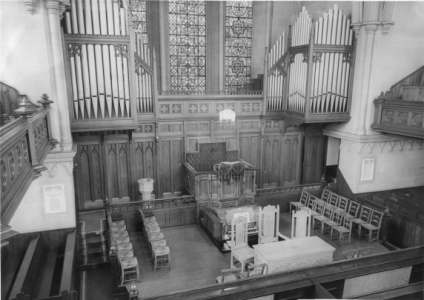 A successful bazaar in 1889 having raised over £850, the seating of the new church was extended by side galleries, and ante-rooms and a hall were erected. The new Church was dedicated on May 30th, 1891. No grand organ was yet installed, but the space formerly reserved as the Chancel may well have suggested such a possibility to some. At any rate, in 1903, mainly owing to the generous gift of £600 from Andrew Carnegie, the new organ was inaugurated free of debt.
A successful bazaar in 1889 having raised over £850, the seating of the new church was extended by side galleries, and ante-rooms and a hall were erected. The new Church was dedicated on May 30th, 1891. No grand organ was yet installed, but the space formerly reserved as the Chancel may well have suggested such a possibility to some. At any rate, in 1903, mainly owing to the generous gift of £600 from Andrew Carnegie, the new organ was inaugurated free of debt.
In connection with the psalmody of the Church a remarkable record of unstinted service was achieved by Messrs.John Russell, father and son, who during a period of well over seventy years acted gratuitously as successive leaders of the praise.
By a majority vote of members in 1896 the decision was made to amalgamate with the Congregational Union, and so the Church became known as Bath Street Congregational Church. The change to its present name of the North Congregational Church dates from the adoption of the new constitution in 1928, Bath Street having long before been renamed Pilmuir Street.
Since the establishment of the Church the Sabbath School has always been one of its strong branches. Even in 1876 the roll was 105. It was subscriptions from the scholars in Mr. Foote's time that met the expense of educating and maintaining the Hindu boys, James Foote and John Paton, who were named after two of the Church's most outstanding figures.
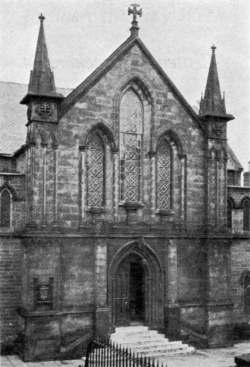 This early zeal for missionary work has continued to be a notable characteristic of the Church, so that today a special link exists between us and the London Missionary Society.
This early zeal for missionary work has continued to be a notable characteristic of the Church, so that today a special link exists between us and the London Missionary Society.
In 1943, by the removal of the railings and the low wall which fenced the Church from the public pavement a great improvement to the frontage of the building was effected and its beauty freely revealed. From time to time the congregation has taken steps (often in the form of voluntary individual effort) to maintain or enhance the internal beauty of the sanctuary. One such addition in recent years was the Baptismal Font, a memorial to those of the Church who died in the Second World War. Harmonizing splendidly with this are the Communion Table and Chairs, generously gifted by the Ladies' Work Party in 1947.
In the hundred years of its history our Church has been served by a succession of able and devoted office-bearers. The names of the ten men whose ministry has advanced the spiritual and general welfare of the congregation will be found elsewhere in this brochure. Through all its vicissitudes the Church has been fortified and sustained by a congregation of great-hearted and faithful people, whose ideals of Christian fellowship and unfaltering endeavour constitute an inspiration as well as a challenge for generations to come.
Last Update: 8 November 2025 | Home | Services | Who are we? | History | Find us | Contact us
